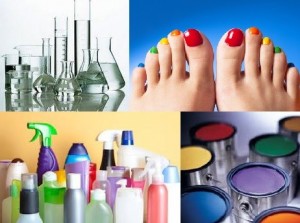Acetone

source : study.com
Lab Preparation of Acetone –
It is prepared in laboratory by heating Anhydrous Calcium acetate.

source : learnnext
Method-
Fused calcium acetate mixed with little iron fillings is taken in a retort, fitted with water condenser & a receiver. Iron fillings help in the uniform distribution of heat.
The retort is heated slowly,when acetone distills over & collected in the receiver. The distillate is shaken with saturated solution of sodium bisulphite then colourless crystals of acetone sodium bisulphite are formed which on treatment with sodium carbonate gives acetone.
The aqueous solution of acetone is dried over Anhy.CaCl2 & redistilled to obtain pure acetone. The fraction is collected between 55 to 570C.( Its boiling point is 560C)
(CH3)2C=O [impure] + NaHSO3—->( CH3 )2C(OH) SO3Na [Acetone Sodium bisulphite compound]
( CH3 )2C(OH) SO3Na + Na2CO3 ——> (CH3)2C=O [pure] + NaHCO3 + Na2SO3
General methods of preparation:
1) By oxidation of Alcohols:
Secondary alcohol on oxidation with K2Cr2O7 + H2SO4 forms ketone.

2) By catalytic dehydrogenation of Alcohols:
On passing the vapors of secondary alcohol over Cu at 300 o C, ketone is formed.

3) From Acetic acid –
By passing vapours of acetic acid over heated MnO catalyst at 3000C, acetone is formed.
CH3COOH + CH3COOH ——>CH3COCH3 + CO2 + H2O
4) By hydrolysis of gem-dihalides-
By the hydrolysis of isopropylidene dichloride with aq. KOH , acetone is formed.
(CH3)2CCl2 +2KOH (aq.)——–> (CH3)2C(OH)2 [unstable compd] —–>CH3COCH3 +H2O
5) By the ozonolysis of Alkenes

source : Chemistry-Tutorvista.com
6) From Grignard reagent-
When Methyl cyanide ( Alkyl cyanide ) reacts with methyl magnesium iodide then addition compd is formed which on hydrolysis gives acetone.
CH3CN + CH3MgI ——> (CH3)2C=NMgI [addition compd] ——> (CH3)2C=O +NH3 + Mg(OH)I
Test –
- Iodoform test- Acetone gives yellow ppt. of iodoform when heated with I2 & NaOH solution or ammonia.(Ethyl alcohol also give yellow ppt. of iodoform when heated with I2 & NaOH solution but not with ammonia)
- It gives red colour with sodium nitroprusside & sodium hydroxide solution.
- It does not react with Schiff’s reagent, tollen’s reagent, fehling solution.
Uses –
- As a solvent for cellulose acetate , cellulose nitrate, celluloid resins etc.
- As a nail polish remover
- In the preparation of chloroform , iodoform , chloretone etc.

source : slideshare.net







